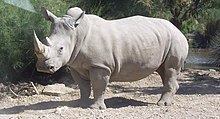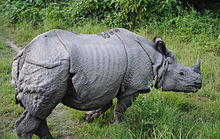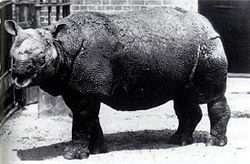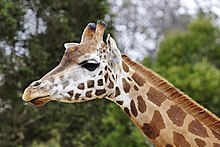The Largest/Heaviest land animal classification is also dominated by mammals, with the African bush elephant being the most massive of these. The African elephant is now listed as two species, the African bush
elephant and the African forest elephant, as they are now generally
considered to be two separate species. The African bush elephant (Loxodonta africana), of the order Proboscidea, is the largest living land animal. A native of various open habitats in Sub-Saharan Africa, this elephant is born commonly weighing about 100 kilograms (220 lb). The largest elephant ever recorded was shot in Angola in 1974. It was a male measuring 10.7 metres (35 ft) from trunk to tail and 4.17 metres (13.7 ft) lying on its side in a projected line from the highest point of the shoulder to the base of the forefoot, indicating a standing shoulder height of 3.96 metres (13.0 ft). Here in this list you will find Top 10 Heaviest Land Animals in the World, Read on:
The African bush elephant (Loxodonta africana) is the larger of the two species of African elephant. Both it and the African forest elephant have usually been classified as a single species, known simply as the African elephant, but recent preliminary evidence has seen the forest elephant classified as a distinct species (although this status is not conclusively accepted due to concerns over conservation strategies until the reclassication is formalised). The African bush elephant is the largest and heaviest land animal on earth, being up to 3.96 m (13.0 ft) tall at the shoulder and 10.4 tonnes (22,930 lb) in weight. On average, males are 3.26 metres (10.7 ft) tall at the shoulder and 7 tonnes (15,430 lb) in weight, while females are much smaller at 2.65 metres (8.7 ft) tall at the shoulder and 3.5 tonnes (7,720 lb) in weight. The most characteristic features of African elephants are their very large ears, which they use to radiate excess heat, and their trunk, a nose and an extension of the upper lip with two opposing extensions, or "fingers" at the end of it.
2. Asian elephant
The Asian or Asiatic elephant (Elephas maximus) is the only living species of the genus Elephas and is distributed in Southeast Asia from India in the west to Borneo in the east. Three subspecies are recognised E. m. maximus from Sri Lanka, the E. m. indicus from mainland Asia, and E. m. sumatranus from the island of Sumatra. Asian elephants are the largest living land animals in Asia. On average, the shoulder height of males rarely exceeds 2.75 m (9.0 ft) and that of the females, 2.4 m (7.9 ft). Average shoulder height of females is 2.4 m (7.9 ft), and average weight is 2.7 t (3.0 short tons), while average shoulder height of males is 2.75 m (9.0 ft), and average weight is 4 t (4.4 short tons). Length of body and head including trunk is 5.5–6.5 m (18–21 ft) with the tail being 1.2–1.5 m (3.9–4.9 ft) long. The largest bull elephant ever recorded was shot by the Maharajah of Susang in the Garo Hills of Assam, India in 1924, it weighed 7 tonnes (7.7 short tons), stood 3.43 m (11.3 ft) tall at the shoulders and was 8.06 m (26.4 ft) long from head to tail.
3. African forest elephant
The African forest elephant (Loxodonta cyclotis) is a forest-dwelling species of elephant found in the Congo Basin. It is the smallest of the three extant species of elephant, but also the third-largest living terrestrial animal. The African forest elephant and the African bush elephant were considered to be one species until genetic studies showed that their relationship is distant. A male African forest elephant rarely exceeds 2.5 m (8 ft) in height, considerably smaller than the bush species which is usually over 3 m (just under 10 ft) and sometimes almost 4 m (13 ft) tall. L. cyclotis reportedly weighs around 2.7 tonnes (5,950 lb), with the largest specimens attaining 6 tonnes (13,230 lb). Pygmy elephants of the Congo Basin, presumed to be a subgroup of L. cyclotis, have reportedly weighed as little as 900 kg (1,980 lb) as adults.
4. White rhinoceros
The white rhinoceros or square-lipped rhinoceros (Ceratotherium simum) is the largest extant species of rhinoceros. It has a wide mouth used for grazing and is the most social of all rhino species. The white rhinoceros is considered to consist of two subspecies: the southern white rhinoceros, with an estimated 20,000 wild-living animals as of 2015, and the much rarer northern white rhinoceros. The northern subspecies has very few remaining, with only three confirmed individuals left (two females and one male), all in captivity. It weighs slightly more on average than a hippopotamus despite a considerable mass overlap between these two species. It has a massive body and large head, a short neck and broad chest. The head and body length is 3.7 to 4 m (12.1 to 13.1 ft) in males and 3.4 to 3.65 m (11.2 to 12.0 ft) in females, with the tail adding another 70 cm (28 in) and the shoulder height is 170 to 186 cm (5.58 to 6.10 ft) in the male and 160 to 177 cm (5.25 to 5.81 ft) in the female. The male, averaging about 2,300 kg (5,100 lb) is heavier than the female, at an average of about 1,700 kg (3,700 lb).
5. Indian rhinoceros
The Indian rhinoceros (Rhinoceros unicornis), also called the greater one-horned rhinoceros and great Indian rhinoceros, is a rhinoceros native to the Indian subcontinent. It is listed as Vulnerable on the IUCN Red List, as populations are fragmented and restricted to less than 20,000 km2 (7,700 sq mi). Moreover, the extent and quality of the rhino's most important habitat, alluvial grassland and riverine forest, is considered to decline due to human and livestock encroachment. Among terrestrial land mammals native to Asia, the Indian rhinoceros is second in size only to the Asian elephant. It is the largest living rhinoceros. Males have a head and body length of 368–380 cm (12.07–12.47 ft) with a shoulder height of 170–186 cm (5.58–6.10 ft), while females have a head and body length of 310–340 cm (10.2–11.2 ft) and a shoulder height of 148–173 cm (4.86–5.68 ft). The male, averaging about 2,200 kg (4,900 lb) is heavier than the female, at an average of about 1,600 kg (3,500 lb). The largest sized specimens range up to 4,000 kg (8,800 lb).
6. Hippopotamus
The hippopotamus (Hippopotamus amphibius), or hippo, is a large, mostly herbivorous mammal in sub-Saharan Africa, and one of only two extant species in the family Hippopotamidae, the other being the pygmy hippopotamus (Choeropsis liberiensis or Hexaprotodon liberiensis). After the elephant and rhinoceros, the common hippopotamus is the third-largest type of land mammal and the heaviest extant artiodactyl. Despite their physical resemblance to pigs and other terrestrial even-toed ungulates, the closest living relatives of the Hippopotamidae are cetaceans (whales, porpoises, etc.) from which they diverged about 55 million years ago. The common ancestor of whales and hippos split from other even-toed ungulates around 60 million years ago. The earliest known hippopotamus fossils, belonging to the genus Kenyapotamus in Africa, date to around 16 million years ago. Common hippos are recognisable by their barrel-shaped torsos, wide-opening mouths revealing large canine tusks, nearly hairless bodies, columnar-like legs and large size; adults average 1,500 kg (3,300 lb) and 1,300 kg (2,900 lb) for males and females respectively.
7. Javan rhinoceros
The Javan rhinoceros (Rhinoceros sondaicus), also known as the Sunda rhinoceros or lesser one-horned rhinoceros, is a very rare member of the family Rhinocerotidae and one of five extant rhinoceroses. It belongs to the same genus as the Indian rhinoceros, and has similar mosaicked, armour-like skin, but at 3.1–3.2 m (10–10 ft) in length and 1.4–1.7 m (4.6–5.6 ft) in height, it is smaller (in fact, it is closer in size to the black rhinoceros of the genus Diceros). Its horn is usually less than 25 cm (9.8 in), smaller than those of the other rhino species. Only adult males have horns; females lack them altogether. Adults are variously reported to weigh between 900 and 2,300 kg (2,000 and 5,100 lb), although a study to collect accurate measurements of the animals has never been conducted and is not a priority because of their extreme conservation status.
8. Black rhinoceros
The black rhinoceros or hook-lipped rhinoceros (Diceros bicornis) is a species of rhinoceros, native to eastern and southern Africa including Botswana, Kenya, Malawi, Mozambique, Namibia, South Africa, Swaziland, Tanzania, Zambia, and Zimbabwe. Although the rhinoceros is referred to as black, its colors vary from brown to grey. These species are now sometimes referred to as the square-lipped (for white) or hook-lipped (for black) rhinoceros. An adult black rhinoceros stands 140–180 cm (55–71 in) high at the shoulder and is 3–3.75 m (9.8–12.3 ft) in length. An adult typically weighs from 800 to 1,400 kg (1,800 to 3,100 lb), however unusually large male specimens have been reported at up to 2,199–2,896 kg (4,848–6,385 lb). The females are smaller than the males. Two horns on the skull are made of keratin with the larger front horn typically 50 cm (20 in) long, exceptionally up to 140 cm (55 in).
9. Giraffe
The giraffe (Giraffa camelopardalis) is an African even-toed ungulate mammal, the tallest living terrestrial animal and the largest ruminant. Its species name refers to its camel-like shape and its leopard-like coloring. Its chief distinguishing characteristics are its extremely long neck and legs, its horn-like ossicones, and its distinctive coat patterns. It is classified under the family Giraffidae, along with its closest extant relative, the okapi. The nine subspecies are distinguished by their coat patterns. Fully grown giraffes stand 4.3–5.7 m (14.1–18.7 ft) tall, with males taller than females. The tallest recorded male was 5.88 m (19.3 ft) and the tallest recorded female was 5.17 m (17.0 ft) tall. The average weight is 1,192 kg (2,628 lb) for an adult male and 828 kg (1,825 lb) for an adult female with maximum weights of 1,930 kg (4,250 lb) and 1,180 kg (2,600 lb) having been recorded for males and females, respectively. Despite its long neck and legs, the giraffe's body is relatively short. Located at both sides of the head, the giraffe's large, bulging eyes give it good all-round vision from its great height
10. Gaur
The gaur also called Indian bison, is the largest extant bovine, native to South Asia and Southeast Asia. The species has been listed as vulnerable on the IUCN Red List since 1986, as the population decline in parts of the species' range is likely to be well over 70% during the last three generations. Population trends are stable in well-protected areas, and are rebuilding in a few areas which had been neglected. The gaur is the tallest species of wild cattle. The Malayan gaur is called seladang, and the Burmese gaur is called pyoun. The gaur has a head-and-body length of 250 to 330 cm (8 ft 2 in to 10 ft 10 in) with a 70 to 105 cm (28 to 41 in) long tail, and is 165 to 220 cm (5 ft 5 in to 7 ft 3 in) high at the shoulder. The average weight of adult gaur is 650 to 1,000 kg (1,430 to 2,200 lb), with an occasional large bull weighing up to 1,500 kg (3,300 lb). Males are about one-fourth larger and heavier than females. In general measurements are derived from gaurs surveyed in India and China. The Seladang, or Malayasian subspecies, may average larger but no scientifically published measurements are known.
So what you think about this list, don't forget to mention :)
Top 10 Heaviest Land Animals in the Worlds
1. African bush elephantThe African bush elephant (Loxodonta africana) is the larger of the two species of African elephant. Both it and the African forest elephant have usually been classified as a single species, known simply as the African elephant, but recent preliminary evidence has seen the forest elephant classified as a distinct species (although this status is not conclusively accepted due to concerns over conservation strategies until the reclassication is formalised). The African bush elephant is the largest and heaviest land animal on earth, being up to 3.96 m (13.0 ft) tall at the shoulder and 10.4 tonnes (22,930 lb) in weight. On average, males are 3.26 metres (10.7 ft) tall at the shoulder and 7 tonnes (15,430 lb) in weight, while females are much smaller at 2.65 metres (8.7 ft) tall at the shoulder and 3.5 tonnes (7,720 lb) in weight. The most characteristic features of African elephants are their very large ears, which they use to radiate excess heat, and their trunk, a nose and an extension of the upper lip with two opposing extensions, or "fingers" at the end of it.
2. Asian elephant
The Asian or Asiatic elephant (Elephas maximus) is the only living species of the genus Elephas and is distributed in Southeast Asia from India in the west to Borneo in the east. Three subspecies are recognised E. m. maximus from Sri Lanka, the E. m. indicus from mainland Asia, and E. m. sumatranus from the island of Sumatra. Asian elephants are the largest living land animals in Asia. On average, the shoulder height of males rarely exceeds 2.75 m (9.0 ft) and that of the females, 2.4 m (7.9 ft). Average shoulder height of females is 2.4 m (7.9 ft), and average weight is 2.7 t (3.0 short tons), while average shoulder height of males is 2.75 m (9.0 ft), and average weight is 4 t (4.4 short tons). Length of body and head including trunk is 5.5–6.5 m (18–21 ft) with the tail being 1.2–1.5 m (3.9–4.9 ft) long. The largest bull elephant ever recorded was shot by the Maharajah of Susang in the Garo Hills of Assam, India in 1924, it weighed 7 tonnes (7.7 short tons), stood 3.43 m (11.3 ft) tall at the shoulders and was 8.06 m (26.4 ft) long from head to tail.
3. African forest elephant
The African forest elephant (Loxodonta cyclotis) is a forest-dwelling species of elephant found in the Congo Basin. It is the smallest of the three extant species of elephant, but also the third-largest living terrestrial animal. The African forest elephant and the African bush elephant were considered to be one species until genetic studies showed that their relationship is distant. A male African forest elephant rarely exceeds 2.5 m (8 ft) in height, considerably smaller than the bush species which is usually over 3 m (just under 10 ft) and sometimes almost 4 m (13 ft) tall. L. cyclotis reportedly weighs around 2.7 tonnes (5,950 lb), with the largest specimens attaining 6 tonnes (13,230 lb). Pygmy elephants of the Congo Basin, presumed to be a subgroup of L. cyclotis, have reportedly weighed as little as 900 kg (1,980 lb) as adults.
4. White rhinoceros
The white rhinoceros or square-lipped rhinoceros (Ceratotherium simum) is the largest extant species of rhinoceros. It has a wide mouth used for grazing and is the most social of all rhino species. The white rhinoceros is considered to consist of two subspecies: the southern white rhinoceros, with an estimated 20,000 wild-living animals as of 2015, and the much rarer northern white rhinoceros. The northern subspecies has very few remaining, with only three confirmed individuals left (two females and one male), all in captivity. It weighs slightly more on average than a hippopotamus despite a considerable mass overlap between these two species. It has a massive body and large head, a short neck and broad chest. The head and body length is 3.7 to 4 m (12.1 to 13.1 ft) in males and 3.4 to 3.65 m (11.2 to 12.0 ft) in females, with the tail adding another 70 cm (28 in) and the shoulder height is 170 to 186 cm (5.58 to 6.10 ft) in the male and 160 to 177 cm (5.25 to 5.81 ft) in the female. The male, averaging about 2,300 kg (5,100 lb) is heavier than the female, at an average of about 1,700 kg (3,700 lb).
5. Indian rhinoceros
The Indian rhinoceros (Rhinoceros unicornis), also called the greater one-horned rhinoceros and great Indian rhinoceros, is a rhinoceros native to the Indian subcontinent. It is listed as Vulnerable on the IUCN Red List, as populations are fragmented and restricted to less than 20,000 km2 (7,700 sq mi). Moreover, the extent and quality of the rhino's most important habitat, alluvial grassland and riverine forest, is considered to decline due to human and livestock encroachment. Among terrestrial land mammals native to Asia, the Indian rhinoceros is second in size only to the Asian elephant. It is the largest living rhinoceros. Males have a head and body length of 368–380 cm (12.07–12.47 ft) with a shoulder height of 170–186 cm (5.58–6.10 ft), while females have a head and body length of 310–340 cm (10.2–11.2 ft) and a shoulder height of 148–173 cm (4.86–5.68 ft). The male, averaging about 2,200 kg (4,900 lb) is heavier than the female, at an average of about 1,600 kg (3,500 lb). The largest sized specimens range up to 4,000 kg (8,800 lb).
6. Hippopotamus
The hippopotamus (Hippopotamus amphibius), or hippo, is a large, mostly herbivorous mammal in sub-Saharan Africa, and one of only two extant species in the family Hippopotamidae, the other being the pygmy hippopotamus (Choeropsis liberiensis or Hexaprotodon liberiensis). After the elephant and rhinoceros, the common hippopotamus is the third-largest type of land mammal and the heaviest extant artiodactyl. Despite their physical resemblance to pigs and other terrestrial even-toed ungulates, the closest living relatives of the Hippopotamidae are cetaceans (whales, porpoises, etc.) from which they diverged about 55 million years ago. The common ancestor of whales and hippos split from other even-toed ungulates around 60 million years ago. The earliest known hippopotamus fossils, belonging to the genus Kenyapotamus in Africa, date to around 16 million years ago. Common hippos are recognisable by their barrel-shaped torsos, wide-opening mouths revealing large canine tusks, nearly hairless bodies, columnar-like legs and large size; adults average 1,500 kg (3,300 lb) and 1,300 kg (2,900 lb) for males and females respectively.
7. Javan rhinoceros
The Javan rhinoceros (Rhinoceros sondaicus), also known as the Sunda rhinoceros or lesser one-horned rhinoceros, is a very rare member of the family Rhinocerotidae and one of five extant rhinoceroses. It belongs to the same genus as the Indian rhinoceros, and has similar mosaicked, armour-like skin, but at 3.1–3.2 m (10–10 ft) in length and 1.4–1.7 m (4.6–5.6 ft) in height, it is smaller (in fact, it is closer in size to the black rhinoceros of the genus Diceros). Its horn is usually less than 25 cm (9.8 in), smaller than those of the other rhino species. Only adult males have horns; females lack them altogether. Adults are variously reported to weigh between 900 and 2,300 kg (2,000 and 5,100 lb), although a study to collect accurate measurements of the animals has never been conducted and is not a priority because of their extreme conservation status.
8. Black rhinoceros
The black rhinoceros or hook-lipped rhinoceros (Diceros bicornis) is a species of rhinoceros, native to eastern and southern Africa including Botswana, Kenya, Malawi, Mozambique, Namibia, South Africa, Swaziland, Tanzania, Zambia, and Zimbabwe. Although the rhinoceros is referred to as black, its colors vary from brown to grey. These species are now sometimes referred to as the square-lipped (for white) or hook-lipped (for black) rhinoceros. An adult black rhinoceros stands 140–180 cm (55–71 in) high at the shoulder and is 3–3.75 m (9.8–12.3 ft) in length. An adult typically weighs from 800 to 1,400 kg (1,800 to 3,100 lb), however unusually large male specimens have been reported at up to 2,199–2,896 kg (4,848–6,385 lb). The females are smaller than the males. Two horns on the skull are made of keratin with the larger front horn typically 50 cm (20 in) long, exceptionally up to 140 cm (55 in).
9. Giraffe
The giraffe (Giraffa camelopardalis) is an African even-toed ungulate mammal, the tallest living terrestrial animal and the largest ruminant. Its species name refers to its camel-like shape and its leopard-like coloring. Its chief distinguishing characteristics are its extremely long neck and legs, its horn-like ossicones, and its distinctive coat patterns. It is classified under the family Giraffidae, along with its closest extant relative, the okapi. The nine subspecies are distinguished by their coat patterns. Fully grown giraffes stand 4.3–5.7 m (14.1–18.7 ft) tall, with males taller than females. The tallest recorded male was 5.88 m (19.3 ft) and the tallest recorded female was 5.17 m (17.0 ft) tall. The average weight is 1,192 kg (2,628 lb) for an adult male and 828 kg (1,825 lb) for an adult female with maximum weights of 1,930 kg (4,250 lb) and 1,180 kg (2,600 lb) having been recorded for males and females, respectively. Despite its long neck and legs, the giraffe's body is relatively short. Located at both sides of the head, the giraffe's large, bulging eyes give it good all-round vision from its great height
10. Gaur
The gaur also called Indian bison, is the largest extant bovine, native to South Asia and Southeast Asia. The species has been listed as vulnerable on the IUCN Red List since 1986, as the population decline in parts of the species' range is likely to be well over 70% during the last three generations. Population trends are stable in well-protected areas, and are rebuilding in a few areas which had been neglected. The gaur is the tallest species of wild cattle. The Malayan gaur is called seladang, and the Burmese gaur is called pyoun. The gaur has a head-and-body length of 250 to 330 cm (8 ft 2 in to 10 ft 10 in) with a 70 to 105 cm (28 to 41 in) long tail, and is 165 to 220 cm (5 ft 5 in to 7 ft 3 in) high at the shoulder. The average weight of adult gaur is 650 to 1,000 kg (1,430 to 2,200 lb), with an occasional large bull weighing up to 1,500 kg (3,300 lb). Males are about one-fourth larger and heavier than females. In general measurements are derived from gaurs surveyed in India and China. The Seladang, or Malayasian subspecies, may average larger but no scientifically published measurements are known.
So what you think about this list, don't forget to mention :)



.jpg/220px-Elephas_maximus_(Bandipur).jpg)




.jpg/220px-Diceros_bicornis_(Etosha).jpg)

_1_by_N._A._Naseer.jpg/220px-Indian_Bison_(Gaur)_1_by_N._A._Naseer.jpg)










0 comments:
Post a Comment